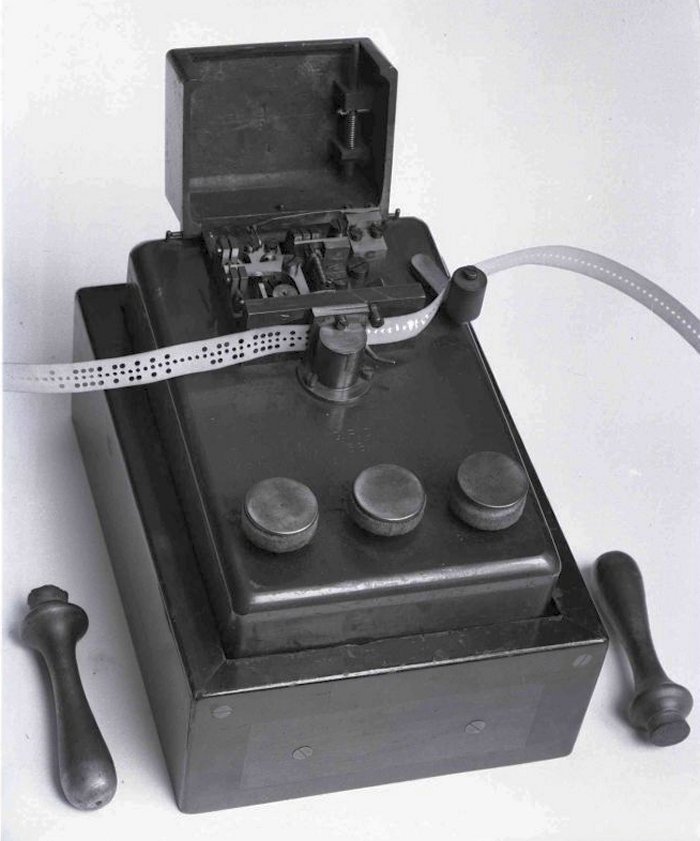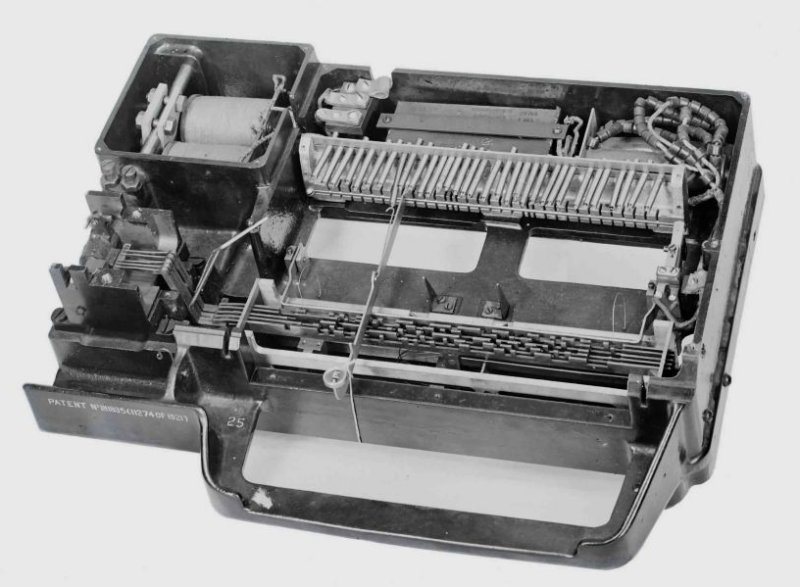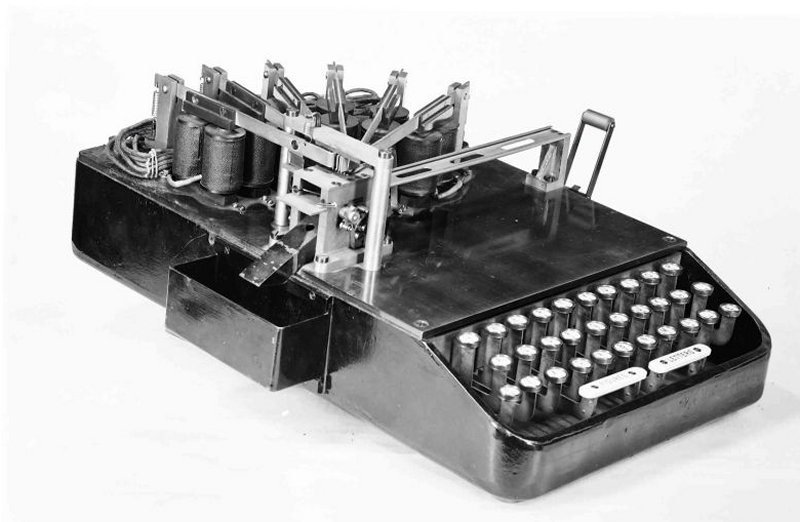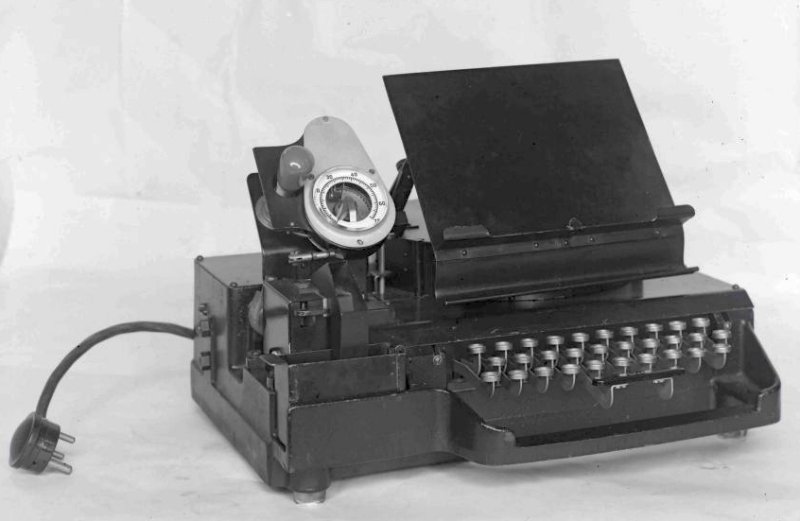|
The GPO telegraph perforator (except the No. 1 & 40) has a keyboard similar to that of a
Teleprinter, and the depression of a key, or the space bar, causes a paper
tape to be perforated in accord with the 5-unit code for that particular
character. The five code elements for a character are arranged transversely
on the paper tape with a hole, or perforation, corresponding to a mark
element and absence of perforation corresponding to a space element. A feed
hole, necessary for the subsequent passage of the tape through a
transmitter, is punched in the tape at the same time as the code
combination.
ONE of the first practical instruments of this type for
Morse characters to be tried by the British Post
Office was that designed
by
the well-known
Wheatstone telegraph engineer, F. G.
Creed. It was brought into use in 1900, air
pressure being employed to effect the
perforations. Fair results were obtained, but the keys
were arranged in three curved rows which made the width
of the
keyboard excessive and difficult for the operators. The telegraphists
did not take to it and eventually it was abandoned.
Keyboard and punched tape layout diagrams -
TG351/4.
Educational Pamphlet -
Outline of operation and mechanical arrangements
Perforators No. 1 Complete
3-tapper Wheatstone perforator, 2-slip.
Includes (1947):-
1 x Base, Perforator, 2 Handles, Punching.
1 x Box, Paper, for Perforator.
1 x Perforator No. l.
Perforators No. 21
Keyboard perforator, Kleinschmidt type (Morse).
Introduced circa 1911.
Perforators No. 22
Keyboard perforator, Gell, one slip type (Morse).
Introduced circa 1905.
Perforators No. 23
Keyboard perforator, Post Office type (Morse).
Perforators No. 24
Keyboard perforator, Post Office type, single magnet (5 unit A).
For inland Baudot circuits.
Perforators No. 25
Keyboard perforator, Post Office type, six magnet (5 unit A).
For foreign Baudot circuits.
Perforators No. 26
Keyboard perforator, Baudot original type (5 unit A).
Perforators No. 27 (Mark 234)
Keyboard perforator, Murray Multiplex type (5 unit B).
Perforators No. 27 (Mark 235)
Keyboard perforator, Murray Multiplex type (5 unit B).
As Mark 234 but keyboard layout differs (1921).
Perforators No. 28
Keyboard perforator, Western Electric Type, Multiplex (5 unit B).
Perforators No. 29
Keyboard perforator, Siemens Automatic (5 unit C).
Perforators No. 30
Keyboard perforator, Post Office type, six magnet (5 unit A).
For foreign Baudot circuits.
Perforators No. 31
Keyboard perforator, Post Office type, six magnet (5 unit A).
For inland Baudot circuits.
Perforators No. 32
Keyboard perforator, Kleinschmidt type (Cable Morse).
Perforators No. 33
Keyboard perforator, Gell (Cable Morse).
Perforators No. 34
Keyboard perforator, Murray original.
This used a re-arranged Baudot code,
the "5 unit B," bringing the
secondary symbols into line with
ordinary typewriter practice.
The perforations are on the lower edge of the tape only.
Perforators No. 35
Keyboard perforator, Gell, four slip type (Morse).
Perforators No. 36
Keyboard perforator, Western Electric Type, Multiplex (5 unit B).
Keyboard modified to standard layout.
Perforators No. 37
Keyboard perforator, Murray Multiplex type (5 unit B).
Keyboard modified to standard layout.
Perforators No. 36
Keyboard perforator, Creed (Cable Morse).
Perforators No. 40
Keyboard perforator, 1-slip.
Morse code.
Creed type.
For wireless working - triple instead of double space between words.
100/110V., D.C. Includes:-
1 x Motor, Electric, D.C., No. 17-100/110V.
1 x Plug, for Socket-outlet No. 8, with Cord 3f77L, 24".
230V., A.C. Includes:-
1 x Condenser 2·5uf (Creed B.O. 1809).
1 x Motor, Electric, A.C. No. 5-230V.
1 x Plug, for Socket-outlet No. 8 with Cord 3/77L, 24".
Perforators No. 43
Keyboard perforator.
5-unit code.
Diagram TG 616.
Single electro-magnet for perforating.
No. 3A code. Includes:-
1 x Block, Terminal No. 21/5.
2 x Parts No. 1/SPL/156.
1 x Condenser, M.C., No. 101.
2 x Resistor, Coil No. 27, 60 ohms.
2 x Desks (1 No. 11).
2 x Resistor, Coil No. 27, 100 ohms.
1 x Resistor, Coil No. 27, 125 ohms.
1 x Plug, for Socket-outlet No. 8, with Cord 3/77L, 24".
Perforators No. 44
Keyboard perforator instrument for producing full perforations in a tape.
Fitted with end-of-line lamp: Mark I and Mark II versions are in use.
Punching mechanism is operated by electromagnet and were developed from the
Murray perforator used on the Murray Multiplex system. . 5-unit code.
Single electro-magnet for perforating.
Teleprinter No. 7, also fitted with counting device.
Includes:-
1 x Block, Terminal No. 21/5 (for earlier supplies).
2 x Parts No. 1/SPL/156.
1 Plug, for Socket-outlet No. 8, with Cord 3/77L, 24".
1 x Block, Terminal No. 21/10.
1 x Condenser, M.C., No. 101, Tropical finish.
1 x Condenser, M.C., No. 101 (for earlier supplies).
1 x Filter, Suppression, No. 16.
2 x Resistor, Coil No. 9, 1000 ohms.
1 x Resistor, Coil No. 9, 1600 ohms.
2 x Resistor, Coil No. 27, 60 ohms.
2 x Resistor, Coil No. 27, 100 ohms.
1 x Resistor, Coil No. 27, 125 ohms. Diagram - TG 765.
Diagrams - TG(L) 1110/0 and 1110/1.
Perforator No. 45
Motor-driven
perforator with saw-tooth keyboard giving improved performance over the
Perforator No. 44. Standard machines are for operation from a.c. mains and
enable all characters of the Teleprinter No. 7 alphabet to be perforated,
with the exception of WRU (secondary of D). End-of-line lamp is provided.
Any individual character may be perforated repetitively by operation of the
RUN-OUT key. This is a motor-driven machine which uses the
energy stored in the rotating motor to operate the punching mechanism. The
keyboard is similar to that used on the Teleprinter No. 11, and locking
arrangements are provided although, as the maximum speed is about 130 words
per minute, there is little risk of an operator "racing" the keyboard.
Made by Creed, their model 7P/N3. Diagram - TG(L) 1211. See
also E.I. Telegraphs,
Teleprinter I1051.
Pictures

Perforator No. 1

Perforator No. 24

Perforator No. 24

Perforator No. 25

Perforator No. 25

Perforator No. 40

Perforator No. 44

Perforator No. 45 |







